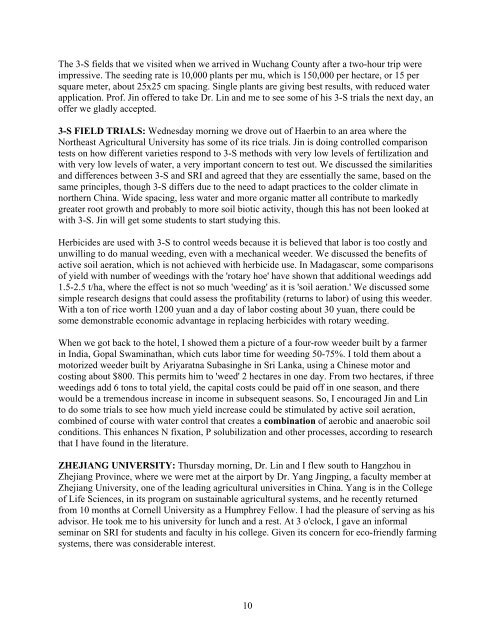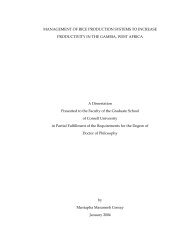Report from SRI China visit - The System of Rice Intensification ...
Report from SRI China visit - The System of Rice Intensification ...
Report from SRI China visit - The System of Rice Intensification ...
You also want an ePaper? Increase the reach of your titles
YUMPU automatically turns print PDFs into web optimized ePapers that Google loves.
<strong>The</strong> 3-S fields that we <strong>visit</strong>ed when we arrived in Wuchang County after a two-hour trip were<br />
impressive. <strong>The</strong> seeding rate is 10,000 plants per mu, which is 150,000 per hectare, or 15 per<br />
square meter, about 25x25 cm spacing. Single plants are giving best results, with reduced water<br />
application. Pr<strong>of</strong>. Jin <strong>of</strong>fered to take Dr. Lin and me to see some <strong>of</strong> his 3-S trials the next day, an<br />
<strong>of</strong>fer we gladly accepted.<br />
3-S FIELD TRIALS: Wednesday morning we drove out <strong>of</strong> Haerbin to an area where the<br />
Northeast Agricultural University has some <strong>of</strong> its rice trials. Jin is doing controlled comparison<br />
tests on how different varieties respond to 3-S methods with very low levels <strong>of</strong> fertilization and<br />
with very low levels <strong>of</strong> water, a very important concern to test out. We discussed the similarities<br />
and differences between 3-S and <strong>SRI</strong> and agreed that they are essentially the same, based on the<br />
same principles, though 3-S differs due to the need to adapt practices to the colder climate in<br />
northern <strong>China</strong>. Wide spacing, less water and more organic matter all contribute to markedly<br />
greater root growth and probably to more soil biotic activity, though this has not been looked at<br />
with 3-S. Jin will get some students to start studying this.<br />
Herbicides are used with 3-S to control weeds because it is believed that labor is too costly and<br />
unwilling to do manual weeding, even with a mechanical weeder. We discussed the benefits <strong>of</strong><br />
active soil aeration, which is not achieved with herbicide use. In Madagascar, some comparisons<br />
<strong>of</strong> yield with number <strong>of</strong> weedings with the 'rotary hoe' have shown that additional weedings add<br />
1.5-2.5 t/ha, where the effect is not so much 'weeding' as it is 'soil aeration.' We discussed some<br />
simple research designs that could assess the pr<strong>of</strong>itability (returns to labor) <strong>of</strong> using this weeder.<br />
With a ton <strong>of</strong> rice worth 1200 yuan and a day <strong>of</strong> labor costing about 30 yuan, there could be<br />
some demonstrable economic advantage in replacing herbicides with rotary weeding.<br />
When we got back to the hotel, I showed them a picture <strong>of</strong> a four-row weeder built by a farmer<br />
in India, Gopal Swaminathan, which cuts labor time for weeding 50-75%. I told them about a<br />
motorized weeder built by Ariyaratna Subasinghe in Sri Lanka, using a Chinese motor and<br />
costing about $800. This permits him to 'weed' 2 hectares in one day. From two hectares, if three<br />
weedings add 6 tons to total yield, the capital costs could be paid <strong>of</strong>f in one season, and there<br />
would be a tremendous increase in income in subsequent seasons. So, I encouraged Jin and Lin<br />
to do some trials to see how much yield increase could be stimulated by active soil aeration,<br />
combined <strong>of</strong> course with water control that creates a combination <strong>of</strong> aerobic and anaerobic soil<br />
conditions. This enhances N fixation, P solubilization and other processes, according to research<br />
that I have found in the literature.<br />
ZHEJIANG UNIVERSITY: Thursday morning, Dr. Lin and I flew south to Hangzhou in<br />
Zhejiang Province, where we were met at the airport by Dr. Yang Jingping, a faculty member at<br />
Zhejiang University, one <strong>of</strong> the leading agricultural universities in <strong>China</strong>. Yang is in the College<br />
<strong>of</strong> Life Sciences, in its program on sustainable agricultural systems, and he recently returned<br />
<strong>from</strong> 10 months at Cornell University as a Humphrey Fellow. I had the pleasure <strong>of</strong> serving as his<br />
advisor. He took me to his university for lunch and a rest. At 3 o'clock, I gave an informal<br />
seminar on <strong>SRI</strong> for students and faculty in his college. Given its concern for eco-friendly farming<br />
systems, there was considerable interest.<br />
10
















